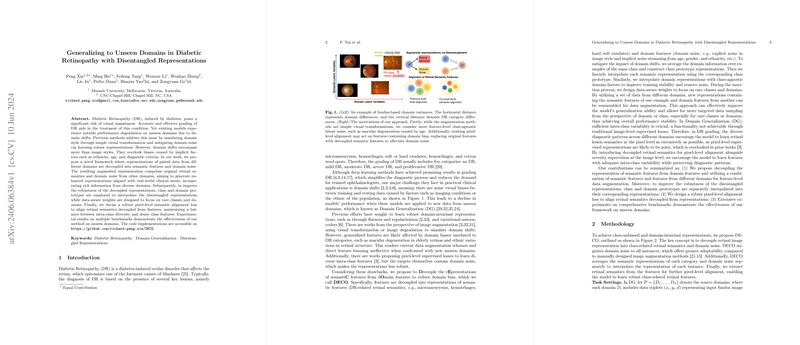Analyzing Generalization to Unseen Domains in Diabetic Retinopathy Using Disentangled Representations
The paper presents a novel approach for improving the generalization of diabetic retinopathy (DR) classification models to unseen domains by leveraging disentangled representations. Given the high variability in retinal images due to differences in imaging conditions, ethnicity, and diagnostic criteria, existing models often experience a decline in performance when applied to data from unseen domains. The proposed method, DECO (Decoupled rEpresentations of semantiC features from dOmain noise), addresses these challenges by decoupling DR-related semantic features from domain-specific noise, thus enhancing the robustness of DR classification models in diverse clinical settings.
Core Methodology
The primary innovation of the paper lies in its decoupling strategy, designed to differentiate between semantic features (e.g., identifying specific retinal lesions indicative of DR) and domain noise (e.g., variations in image style and demographic differences). Once decoupled, these features are recombined in a novel fashion with domain noise borrowed from other samples. This recombination aims to enrich the data representation by simulating varied domain conditions, thus fostering a more robust generalization across unseen domains.
- Representation Decoupling: The method employs instance normalization to separate semantic information from domain noise effectively, thereby facilitating the creation of more generic representations that mitigate domain-induced biases.
- Augmented Representations: By combining semantic features from one example with domain noise from another, the proposed approach generates augmented data that encompasses a spectrum of potential domain variations. Averaging over class-based features and domain noise helps stabilize training and reduces domain bias, particularly for rare classes.
- Prototype-enhanced Synthesis: The introduction of class and domain prototypes allows for the balancing of semantic and domain-invariant representations, refining the model's learning dynamics and enhancing its adaptability to rare class instances.
- Pixel-Level Semantic Alignment Loss: To further bolster the model's robustness, a pixel-level alignment loss is introduced to ensure the capture of intricate intra-class variability while maintaining discriminatory power across classes.
Experimental Evaluation
The effectiveness of this approach is demonstrated through extensive experiments on several datasets, including leave-one-domain-out and single-domain generalization settings. The results indicate that DECO consistently outperforms traditional empirical risk minimization (ERM) methods and several state-of-the-art domain generalization approaches. Noteworthy improvements were found in the APTOS and IDRID datasets, often associated with significant visual diversity and challenging domain shifts. The disentangled and prototype-enhanced representations greatly contribute to improved performance, affirming the potential of the proposed DR classification framework in real-world clinical applications.
Implications and Future Directions
The practical implications of deploying models capable of generalizing across unseen domains are profound, particularly in the automatic screening of diabetic retinopathy, a condition with substantial variability in diagnostic presentation. These results suggest that carefully crafted representation learning techniques can effectively tackle domain variability, thereby reducing reliance on domain-specific data collections and potentially minimizing the demand for extensive domain-specific labeling efforts.
Future research directions could explore extending disentanglement techniques to incorporate temporal dynamics in longitudinal healthcare data or integrating additional modalities, such as optical coherence tomography, for more comprehensive ophthalmic assessments. Furthermore, investigation into the application of such techniques for other health conditions characterized by diverse demographic and geographic variability could yield substantial benefits for generalized medical AI deployment.
In conclusion, this research delineates a robust framework for tackling domain shifts in DR diagnosis through advanced disentangled representation learning, setting a precedent for further exploration and refinement of domain-agnostic learning mechanisms in the medical AI domain.
